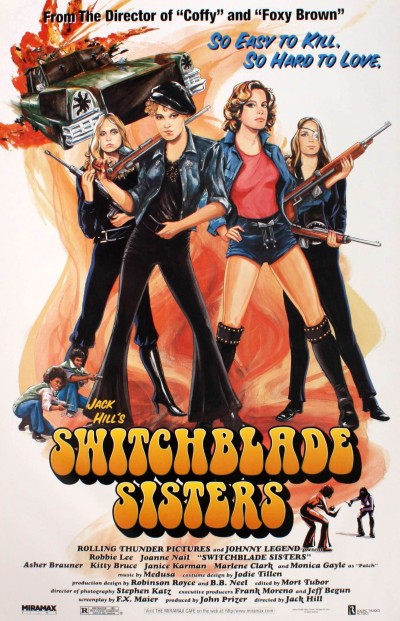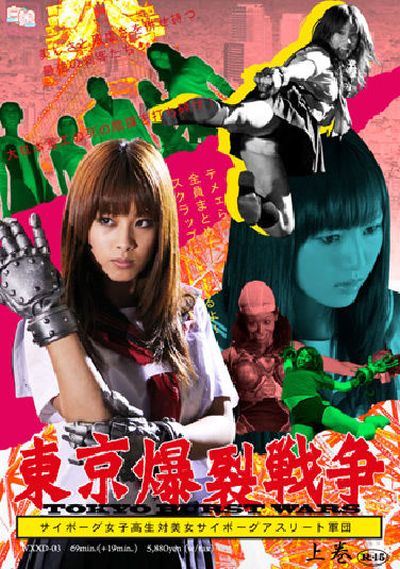★★★
“Oh, look: their tops have come off…”
 It’s important to realize that you need to be familiar with the pinky violence genre that this lovingly replicated and parodies, in order to get the most from it. If not, this will seem over-wrought, incredibly over-acted and more than slightly ridiculous, not least in the way that bras are apparently an unknown item in Japan. But, if you’ve seen enough of the movies that inspired it, you will appreciate from where it’s coming.
It’s important to realize that you need to be familiar with the pinky violence genre that this lovingly replicated and parodies, in order to get the most from it. If not, this will seem over-wrought, incredibly over-acted and more than slightly ridiculous, not least in the way that bras are apparently an unknown item in Japan. But, if you’ve seen enough of the movies that inspired it, you will appreciate from where it’s coming.
“I make my formal greeting. I was born and raised in Chicken Valley. My father was a poultry farmer. From age seven, I slaughtered chickens, 444 in total. By name I am Red Malice, Yumi the Cockscomb.”
Yeah, it’s like that. The heroine, Midori – a.k.a. Invincible Midori, the Wild Chrysanthemum – used to be a big shot, but now just wants the quiet life for her and her friends at her school, even though she could run it if she wanted. “It’s a mess, what’s the point? This way, I can do what I want,” Midori says. But, as you can imagine, she isn’t left in piece. For instance, there’s Maki, who has been trying to defeat Midori since they were both children. But worse still is Ranko and her Demon Gang, who operate as the strong arm of the principal and pimp unwilling members of this fine educational establishment out to his lecherous friends. There’s an uneasy truce between Ranko and Midori, but that is shattered after Harue seeks protection from the former, and her plight reminds Midori of exactly why she dropped out of the gang business.
From there, things escalate in the way they usually do, with Midori honey-potting a politician and the principal, then using the photographs to foment rebellion among the other students. However, the principal retaliates by turning to his brother, head of the Inagaki Gang, who retake the school while Midori is busy dealing with Maki, setting up the final, explosive battle. In other words, it’s basically a pastiche, gluing together the tropes familiar from just about any example in the field, and turning the dial on them all, just a little bit higher. Most obviously, it’s almost de rigeur in the originals for the heroine’s top to be ripped open when she fights. Here, with refreshing honesty, that’s virtually the opening move. The main weakness is probably the lead (Hoshimi, I think – though since this doesn’t appear to have an IMDb entry, I’m kinda guessing), who is kinda bland and colourless, especially beside the actresses playing Maki and Ranko. This is the kind of thing where the performers need to throw all inhibition out the window: when that happens, you can certainly see where they’re going. However, it only happens intermittently, rather than with the consistency necessary to be truly successful.
Dir: Toshiya Kominami
Star: Rika Hoshimi, Asuka Misugi, Saya Kobayashi, Yoko Fujimura





 It takes real effort for a film that’s barely an hour long, significantly to overstay its welcome, but SBG manages to do exactly that, thanks to its woeful combination of shoddy action and tedious sex scenes. The heroine is teenager Mirai Asamiya (Hashimoto, about as much an actual teenager as I am), who has been transferred to a new school at the behest of her father. Little does she know, at least initially, that she is simply a tool for his revenge, headmaster Bush (Hotaru) having seduced Mirai’s mother away from her husband, and run off with her. To this end, Mirai has been brought up with what we should call, a very particular set of skills: we’ll spare you the details of exactly what the “Venus Crush” involves, but it does lead to the classic line, “He doesn’t know how dangerous your vagina is!” Before she can reach her target, she has to get close by dethroning and replacing his current enforcer of discipline, Susan (Taguchi), and also get past Bush’s lesbian daughter (Kiyokawa).
It takes real effort for a film that’s barely an hour long, significantly to overstay its welcome, but SBG manages to do exactly that, thanks to its woeful combination of shoddy action and tedious sex scenes. The heroine is teenager Mirai Asamiya (Hashimoto, about as much an actual teenager as I am), who has been transferred to a new school at the behest of her father. Little does she know, at least initially, that she is simply a tool for his revenge, headmaster Bush (Hotaru) having seduced Mirai’s mother away from her husband, and run off with her. To this end, Mirai has been brought up with what we should call, a very particular set of skills: we’ll spare you the details of exactly what the “Venus Crush” involves, but it does lead to the classic line, “He doesn’t know how dangerous your vagina is!” Before she can reach her target, she has to get close by dethroning and replacing his current enforcer of discipline, Susan (Taguchi), and also get past Bush’s lesbian daughter (Kiyokawa).
 The briskly-moving piece of seventies trash is much beloved by Quentin Tarantino, and I have to agree with him about its merits. While some elements haven’t stood the test of time well, in other ways, it’s well ahead of its era, and there is, literally, never a dull moment here. Initially, the teenage girl gang are the Dagger Debs, a somewhat subservient bunch to their male counterparts, the Silver Daggers, and their leader, Dominic (Brauner). He’s paired up with the Debs’ #1, Lace (Lee), but has eyes for new girl Maggie (Nail), who is soon impressing Lace with her street smarts and toughness.
The briskly-moving piece of seventies trash is much beloved by Quentin Tarantino, and I have to agree with him about its merits. While some elements haven’t stood the test of time well, in other ways, it’s well ahead of its era, and there is, literally, never a dull moment here. Initially, the teenage girl gang are the Dagger Debs, a somewhat subservient bunch to their male counterparts, the Silver Daggers, and their leader, Dominic (Brauner). He’s paired up with the Debs’ #1, Lace (Lee), but has eyes for new girl Maggie (Nail), who is soon impressing Lace with her street smarts and toughness. I’m on the fence with regard to the Japanese uber-gore films, most notably, by the Sushi Typhoon studio, which have achieved renown (or infamy) of late. While some (
I’m on the fence with regard to the Japanese uber-gore films, most notably, by the Sushi Typhoon studio, which have achieved renown (or infamy) of late. While some ( This is definitely a case where less would have been more, and with a more enthusiastic hand on the editor’s knife, this could have become a decent eighty-minute feature – and possibly an even better 50-minute one. Kamikura does often demonstrate an awareness and acceptance of exactly how ludicrous the entire scenario is, and the film is at its best when wholeheartedly embracing its own insanity. For instance, each of the cyborg athletes’ talents is influenced by their sport: Hitomi Oka is a tennis-player, so whacks people with an over-sized, pneumatic racket, and lobs exploding tennis-balls at them. Additional helpings of that kind of imaginative lunacy – and considerably less tied-up schoolgirls being prodded or whipped – would certainly have made for a more entertaining end product.
This is definitely a case where less would have been more, and with a more enthusiastic hand on the editor’s knife, this could have become a decent eighty-minute feature – and possibly an even better 50-minute one. Kamikura does often demonstrate an awareness and acceptance of exactly how ludicrous the entire scenario is, and the film is at its best when wholeheartedly embracing its own insanity. For instance, each of the cyborg athletes’ talents is influenced by their sport: Hitomi Oka is a tennis-player, so whacks people with an over-sized, pneumatic racket, and lobs exploding tennis-balls at them. Additional helpings of that kind of imaginative lunacy – and considerably less tied-up schoolgirls being prodded or whipped – would certainly have made for a more entertaining end product. Purely coincidental that I viewed this not long after
Purely coincidental that I viewed this not long after  This is the third version of the same concept I’ve seen, following some years after the
This is the third version of the same concept I’ve seen, following some years after the 
















 Recent high-school graduate Cassie (Cobb) works at a bank alongside her mother (Quinlan), bickering about the usual things, such as whether to go to college or not. This mundance existence is suddenly interrupted by a robbery: Cassie is stunned to realize the raiders are actually some of her school friends. When they realize this, the girls are forced to take her along, and she discovers the cause of the crime – the father of one (Thomson) has been kidnapped while on business in Mexico. Meanwhile, Mom is tracking down her kidnapped daughter, FBI agent Mendoza (Blasi) is also on the hunt, and one of the girl gang has her own plans for the ill-gotten gains, which doesn’t involve any ransom.
Recent high-school graduate Cassie (Cobb) works at a bank alongside her mother (Quinlan), bickering about the usual things, such as whether to go to college or not. This mundance existence is suddenly interrupted by a robbery: Cassie is stunned to realize the raiders are actually some of her school friends. When they realize this, the girls are forced to take her along, and she discovers the cause of the crime – the father of one (Thomson) has been kidnapped while on business in Mexico. Meanwhile, Mom is tracking down her kidnapped daughter, FBI agent Mendoza (Blasi) is also on the hunt, and one of the girl gang has her own plans for the ill-gotten gains, which doesn’t involve any ransom.